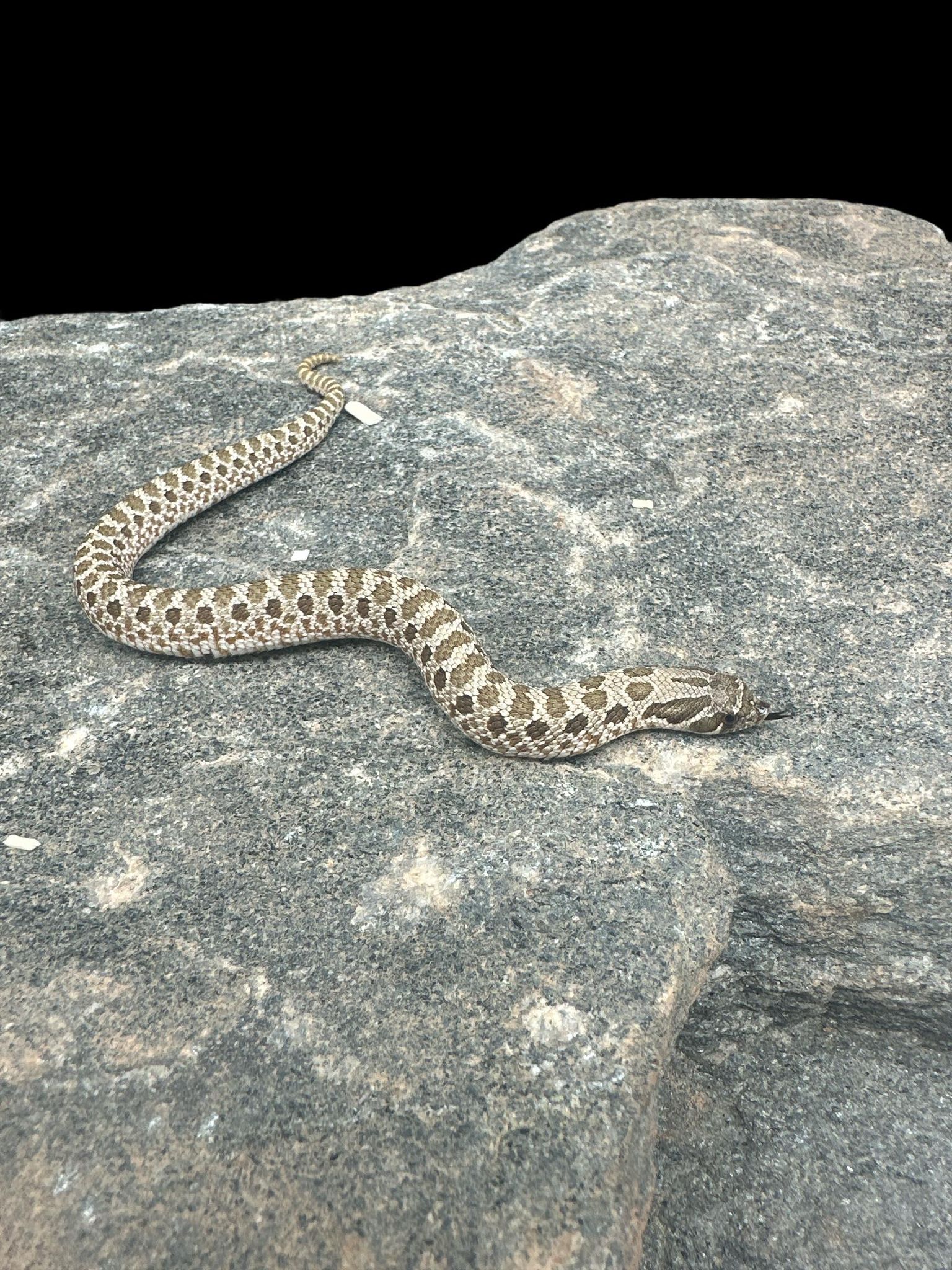Photo Disclaimer
Description
Western Hognose (Poss. Arctic het. Coral)
Scientific Name: Heterodon nasicus
Common Name: Western Hognose Snake
Species Overview
Size: Adult females typically reach 2–3 feet (0.6–0.9 m) in length, while males average 1.5–2 feet (0.45–0.6 m). Both sexes feature the species’ characteristic upturned snout, adapted for digging and burrowing in loose soils.
Appearance: The Poss. Arctic het. Coral Western Hognose displays the classic wild-type pattern of sandy brown base tones and dark dorsal blotches, but may carry subtle hints of the Arctic gene—an incomplete dominant trait that lightens and refines the pattern. In some individuals, Arctic expression can be faint or inconsistent, making it difficult to confirm visually without breeding results. The confirmed Coral gene, when expressed, enhances pink and orange tones as part of a selectively bred Albino line. This combination of subtle visual potential and strong recessive genetics gives this snake considerable breeding value and the possibility of producing vibrant Coral or Arctic-based offspring.
Distribution: Native to central North America, from southern Canada through the Great Plains and into northern Mexico.
Habitat: Western Hognose Snakes inhabit open prairies, grasslands, and semi-arid regions with sandy or loose soil ideal for burrowing. In captivity, this morph thrives in terrestrial terrariums with soft substrate, climbing décor, and secure hiding areas.
Behaviour: Western Hognoses are diurnal, curious, and alert snakes known for their dramatic bluff displays, which may include hissing, neck flattening, or mock strikes. These displays are harmless, and with regular handling, they settle into confident, inquisitive animals.
Captive Care
Enclosure: Provide an enclosure at least 3 feet × 18 inches × 18 inches for adults, using deep, soft substrate such as aspen, soil, or a sand-soil blend. Include multiple hides, smooth décor, and low branches for enrichment.
Temperature & Humidity: Maintain a daytime gradient of 78–86°F (25–30°C) with a basking area near 90°F (32°C). Allow nighttime drops to 70–74°F (21–23°C). Keep humidity between 30–50%, slightly increasing during shedding.
Diet: Offer thawed rodents approximately 1.25× the width of the snake’s mid-body. Feed juveniles every 4–5 days and adults every 7–10 days. Western Hognoses are reliable feeders that adapt easily to routine schedules.
Behaviour in Captivity: Hardy, engaging, and active, Western Hognoses thrive with consistent care and stable conditions. They are often seen burrowing or exploring during daylight hours and tolerate handling well once accustomed.
Special Considerations: Western Hognoses are mildly rear-fanged, and their venom poses minimal risk to humans unless an allergic reaction occurs. Handle calmly and house them individually to avoid feeding-related aggression or stress.
Genetics Note
Possible Arctic (Incomplete Dominant): May possess a subtle or low-expression form of the Arctic gene. Arctic Western Hognoses typically exhibit lighter, cooler tones and sharper contrast, but expression can vary greatly—making identification difficult without breeding confirmation.
het. Coral (Recessive Carrier): Carries one copy of the Coral gene, a selectively bred Albino line known for producing strong pink and orange coloration when visual. (“het” stands for heterozygous—carrying one copy of a gene but not expressing it—and “poss.” indicates the gene or trait may be present but is unconfirmed.)
Genetic Combination Summary
The Western Hognose (Poss. Arctic het. Coral) may express one incomplete dominant trait at a low level and carries one recessive gene:
-
Possible Arctic (Incomplete Dominant): May lighten tones and sharpen contrast if present and expressed.
-
het. Coral (Recessive Carrier): Enables production of pink and orange-toned offspring when paired with another Coral or compatible Albino-type carrier.
This morph combines natural wild-type appeal with promising hidden genetics. Whether Arctic proves visual or remains subtle, its pairing potential makes it a strong candidate for producing pastel-toned or Coral Arctic combinations in future projects.

